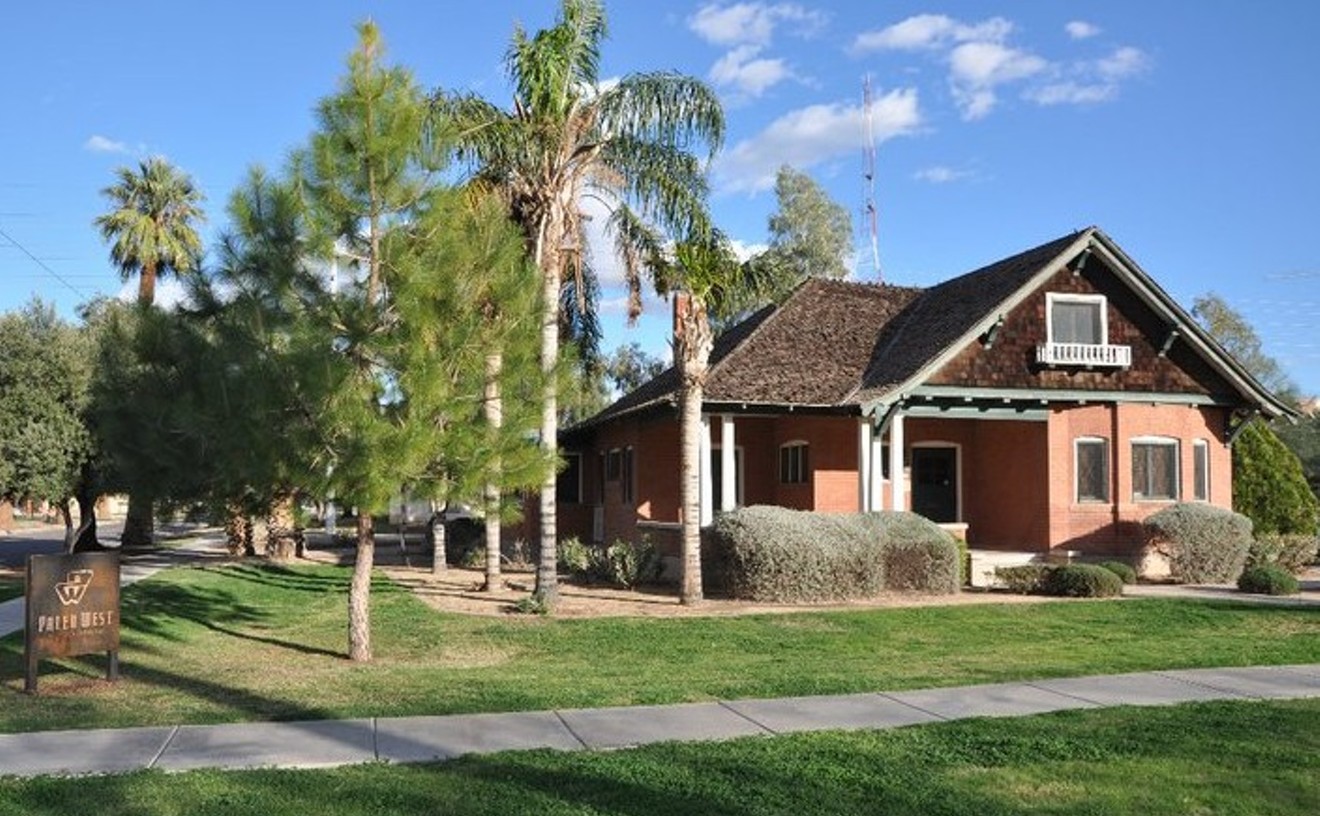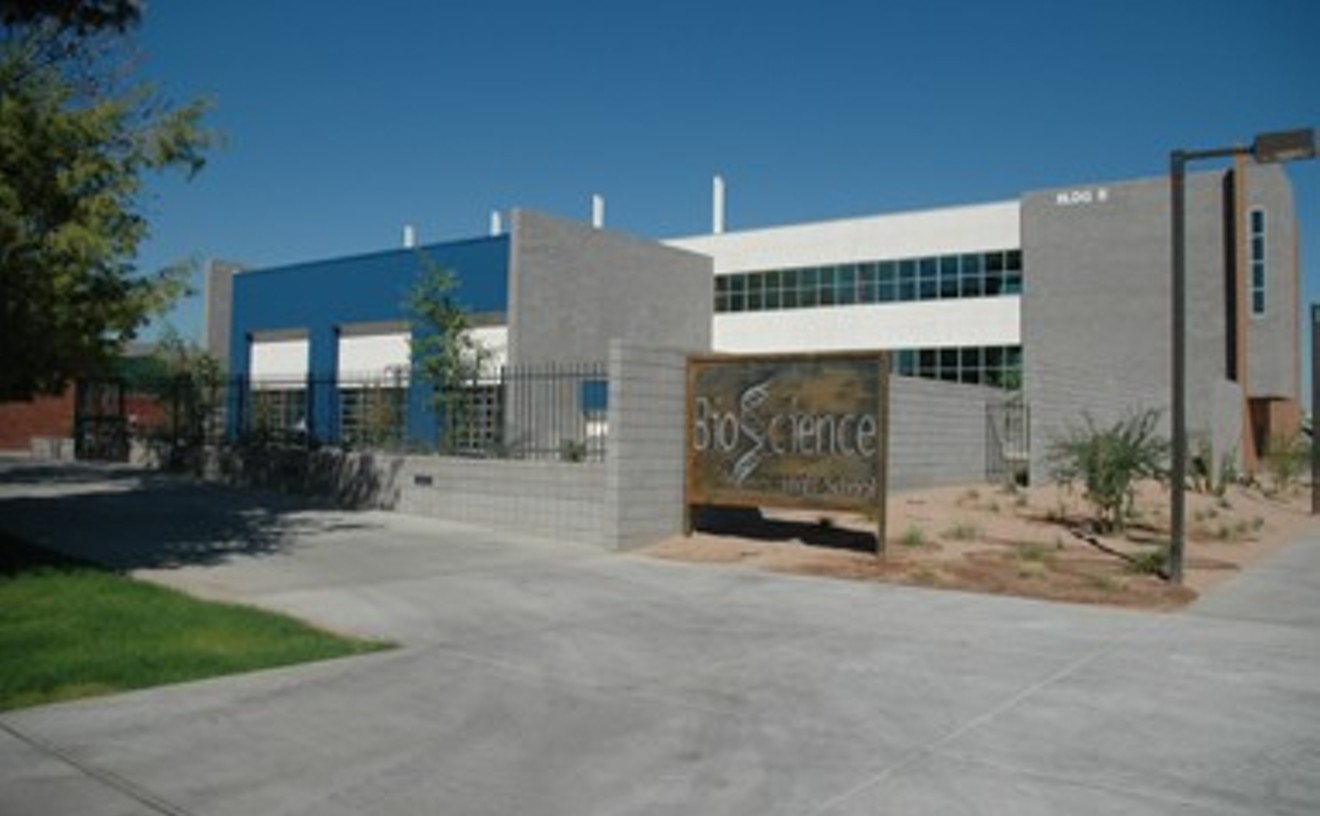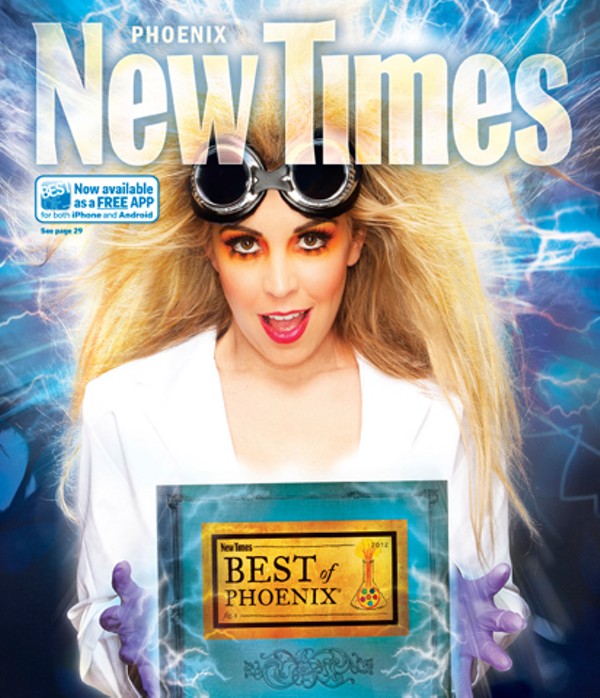Today, if you are exposed to nerve gas — like the sarin used in the notorious 1995 Tokyo subway attacks — the best that anyone can do for you is administer a cocktail of drugs that may keep your heart beating long enough for the gas to wear off on its own. The drugs themselves are dangerous, and they do not stop any of the damage that nerve gas causes. But researchers at Mor Lab at ASU are working to change all that using genetically engineered plants and a blender that would look more at home at a Jamba Juice than in a laboratory.
It turns out that our bodies already possess an enzyme that not only deactivates the chemicals in nerve gas but also rips them apart at the molecular level. The problem is that we naturally produce this chemical, butyrylcholinesterase (BchE), at such low levels that it cannot help us in the event of a nerve gas attack. BchE is a complex molecule and nearly impossible to isolate or synthesize in any quantity. That is why researchers at Mor Lab are teaching tobacco plants how to grow the chemical for us. By splicing the ability to create BchE into plants, they can grow entire fields of this life-saving enzyme. Because they are plants, harvesting is easy; they just need to blend the whole plant and extract the BchE. Clearly, there is still much work to be done, but the initial results are extremely promising. Who thought tobacco could do such good?Best Hope for Surviving a Nerve Gas Attack
Bioscavenger Project, Mor Lab at ASU Biodesign Institute
Best Use of Dirty Pool Water to Save Humanity
ASU's Laboratory for Algae Research and Biotechnology
Arizona has more pools per capita than anywhere in America. Given our weather, that's not really a shocker. What might be shocking is that some of the stuff that grows in your pool if you don't clean it might actually end up saving humanity.
The Laboratory for Algae Research and Biotechnology at ASU is conducting a whole raft of research centered on humble algae, the green crud that gathers in old pools and lakes. Some of the most exciting research is with algae-based biofuels. Current biofuels rely upon converting crops, primarily food crops like corn, into biofuels that we can use in our cars. While this has seen some success, there are real ethical problems with using food for fuel, as well as questions as to whether it actually is sustainable enough to justify biofuel production. That's where the algae comes in. Algae neatly steps around the ethical and practical problems surrounding biofuels. For obvious reasons, nobody is going to complain if a vast algae harvest is used to make fuel, nor do we have to sacrifice wide swaths of farmland just to make it. Researchers at ASU can grow a lot of algae in a very small area, and all they need is water, sunlight and some basic nutrients. The algae themselves produce oils which can be harvested and then refined into biofuel. Harvesting a "crop" of biofuels is as easy as emptying out their tank and giving it a good scrub.Best Place to Test Drive a Space Rover
Arizona -- NASA's Space Exploration Vehicle (SEV) and NASA's Desert Research and Technology Studies (D-RATS) team
While Arizona's frequent haboobs, blazing summers, and year-round dryness can be a challenge for residents, it's also the perfect weather for testing equipment we one day hope to send into space. NASA's Desert Research and Technology Studies (D-RATS) team descends on the Arizona desert every summer to put new space-exploration technology and principles through the torture of an Arizona summer. While they are in the desert, the D-RATS team perform a variety of simulated space missions.
Some of the most recent experiments have been with the unambiguously named Space Exploration Vehicle (SEV). The SEV is like the wild space-going spawn of a pickup truck and a camper trailer, suitable for missions to Mars or to the surface of an asteroid. It's designed to be able to travel thousands of miles over rocky terrain with little or no maintenance. Astronauts can operate the vehicle in a "shirtsleeve" environment but quickly transfer into their spacesuits for a walk outside. While they are in the desert, the D-RATS team perform a variety of simulated space missions. Driving the SEV is unlike anything else out there because it has the ability to turn its multitude of wheels in virtually any direction and even use hydraulics to "crab walk" sideways across very difficult terrain. Granted, for as cool as it sounds, the SEV isn't for those with a need for speed. It clocks a top speed of only 10 kilometers per hour.Best Use of a Camera on Mars
Thermal Emission Imaging System (THEMIS) at Mars Space Flight Facility
Researchers at ASU helped throw the Mars Odyssey orbiter into space way back in 2001. One of the major pieces of equipment they are responsible for was the THEMIS (Thermal Emission Imaging System). The THEMIS is much more than a super-expensive digital camera. It's a super-expensive digital camera that can take pictures of the infrared spectrum.
Looking into the infrared means that the Mars Odyssey probe is able to see things from orbit that a regular camera could not. It can spot things like the residual heat from deep geothermal systems or compare types of rocks just by how they retain or reflect heat from the sun. Superficially, this just means it sends back a bunch of black-and-white photos, but its real value becomes clear when you try to do something a little crazy. Like land a nuclear-powered Cooper Mini on the surface of Mars using a rocket skycrane. Before the Curiosity Mars rover even neared the Red Planet, THEMIS sat in high orbit scoping out landing sites for the probe. From those pictures, scientists were able to help pick out an ideal landing site along the Gale Crater for the rover. The data they collected allowed them to look even more closely at the surface, picking a spot that appeared to be free of massive rocks. And, given the success of Curiosity, it looks like THEMIS chose well.Best Local Indiana Jones
Todd Bostwick, PaleoWest Solutions in Archaeology

For those who say Arizona has no history, Todd Bostwick would like a word with you. The senior research archeologist at PaleoWest Archaeology and executive director of the Verde Valley Archaeology Center in Camp Verde, Bostwick has been working in the field for more than 40 years. So he's got some history — including multiple degrees and a résumé that is, no joke, 12 pages long. How does a guy acquire such an extensive portfolio in a field that would drive the not-so-meticulous insane? Well, unlike most of us, Bostwick has had a passion for his current field since childhood. Long before the days of Indiana Jones, Bostwick was digging up century-old toys he found in the yard of his parents' Nevada home.
Lucky for Phoenix, Bostwick enjoys sharing his archeological finds (his specialties are rock art and ancient astronomy) with others, even going so far as to do house calls (assuming you've found ancient treasures in your backyard). Alongside his more technical published works, Bostwick has published informational books that are more conducive to the everyday amateur scientist, including Landscape of the Spirits: Hohokam Rock Art at South Mountain Park and Beneath the Runways: Archaeology of Sky Harbor International Airport.And though he recently retired from the city of Phoenix after serving as city archaeologist for more than 20 years, Bostwick admits he'll never truly stop digging. See a slideshow here.- 649 N. 3rd Ave., Phoenix, 85003 Map
- 602-261-7253
- www.paleowest.com
Best Brain Surgeon
Dr. Robert F. Spetzler at Barrow Neurological Institute

We hope to never suffer any cerebral damage in our lifetime, but we do know the right guy for the job, if the worst happens. (Come to think of it, we should probably write down his name and tape it to the fridge in case of said damage.) Dr. Robert Spetzler is director of the Barrow Neurological Institute at St. Joseph's Hospital, where he and his team lead the nation in the number of brain surgeries performed and brain surgeons trained. A celebrity in the medical world, Dr. Spetzler specializes in aneurysms, skull base tumors, and other brain malformations and has operated on nearly 6,000 brain aneurysms in his career, which is more than anyone else in the world.
In 1986, Dr. Spetzler took on the role of director at Barrow and banded together a group of skilled neurosurgeons to form Barrow Neurological Associates. He helped create a residency program that medical students from across the country aspire to make, at a hospital that patients all over the globe seek access to. He also was a key player in developing a life-saving surgical technique (the cardiac standstill) for safely removing aneurysms, as well as new surgical tools, including the 3D microscope. The man's busy. So while it's nice to know he's there if we need him, if you foresee yourself engaging in any act of physical stupidity, we suggest you take his advice and "helmet your head." See a slideshow here.- 350 W. Thomas Rd., Phoenix, 85013 Map
- 602-406-6281
- www.barrow.org
Best Way to Learn How to Make Your Garden Really Grow
Maricopa County Master Gardener Program
If you've ever tried to plant something in Phoenix, you've probably realized it takes a little more than "just add water" to get something to grow (or, harder yet, survive). Luckily, there are teaching professionals like Carol Stuttard to help you contrary Marys get your gardens up and growing. Among her credentials (which include certified desert landscape garderer at the Desert Botanical Garden and president of the Scottsdale Community Garden Club), Stuttard is a Maricopa County master gardener.
You can be one, too.The Maricopa County Master Gardener program is part class, part volunteer service that digs into the science of horticulture as it applies to the desert. Master gardeners complete the program with a thorough knowledge of the what, where, when, and how of growing plants in Phoenix. They then take that knowledge and use it to better the community by contributing 50 hours or more to program-approved services such as managing gardening phone lines and providing educational programs to adults, students, and children.Troubled gardeners not in the program can even take their plants, on assigned days, to the one of the several master gardener office locations for what the program calls their Diagnostic Clinic. Of course, the master gardener program doesn't have to be a one-time deal. Program graduates can maintain their master gardener status by fulfilling 12 hours of additional training and 25 hours of addition service each year. It's the green gift that keeps on giving in a too-often crunchy-brown town. See a slideshow here.- 4341 E. Broadway Rd., Phoenix, 85040 Map
- 602-827-8200
- www.ag.arizona.edu/maricopa/garden
Best School for a Mad Scientist in Training
Bioscience High School

Finding a good public school can be a challenge, but it can be especially challenging if your child stays up late watching reruns of Bill Nye the Science Guy and Dexter's Laboratory. If your child has been bitten by the science bug, it might be prudent to enroll him or her in a high school that has science in the name.
Bioscience High School is a magnet school with a serious focus on education in the life sciences. In addition to the standard public school curriculum, it also exposes students to opportunities they are unlikely to find anywhere else in the Valley. For instance, the school has received a hefty grant from Intel to help build a biofuel program. Students have filled several nearby vacant lots with rows upon rows of sunflowers. These sunflowers are harvested for their seeds which are pressed for oil. These oils are then processed into biofuel, which powers an alternative-fuel vehicle designed and built by the students themselves. Beyond that, the school has an active and competitive robotics team. Besides, you know that a school is serious about the biological sciences when it has a desert tortoise named Isis and a mascot named the Double Helix Dragons. Bioscience High School is part of the Phoenix Union High School District and has open enrollment for anyone within its geographical boundaries. Students living outside of those boundaries can still enroll on a space-available basis.- 512 E. Pierce St., Phoenix, 85004 Map
- www.phoenixunion.org/bioscience
Best Use of Technology to Make Being Lazy Even Easier
AdSkip
TiVo and other DVR technology has been a boon for couch potatoes. Gone are the days when humanity was actually forced to watch commercials or plan their lives around watching specific shows at specific times. But DVRs have one serious drawback: If you are watching something live and it goes to commercials, what do you do while you wait for your show to come back on?
The answer is AdSkip, an award-winning prototype device developed by a trio of ASU engineering majors — Anthony Thau, Chase Parenteau, and Chris McBride — and submitted to an Intel-sponsored competition in Shanghai. (They won second place in their category.) AdSkip uses complex algorithms to detect when a TV show is about to cut to commercial and instantly changes the channel to something better. That "something better" could be another show or even the Internet. When your show returns from its commercial break, AdSkip pops the digital clutch and drops you back into the action. Sure, humanity has been doing this for decades by means of the "television remote control," but this is the 21st century! There is absolutely no reason why you should have to push a physical button to get this kind of result.Best Animal Testing in the Name of Animals
Canine Hereditary Cancer Consortium at the Translational Genomics Research Institute (TGen)
Animal testing is generally a concept that raises the hackles of animal lovers everywhere. However, some testing doesn't just help people; it also helps our canine friends. Researchers at TGen are busy collecting thousands of samples from dogs who have developed cancer in the hopes of figuring out exactly which genetic factors lead to cancer.
Research to date indicates that the chances of getting cancer depend in no small part on whether you inherited the wrong genes from your parents. But due to the complexity of genetics and other factors, we have not yet managed to isolate exactly which genes make people more susceptible to cancer. It's very likely that cancer isn't triggered by one bad gene but rather several genes malfunctioning in concert with one another. TGen is collecting specimens from purebred dogs because their highly selective breeding means that there is low genetic variability between dogs of the same breed. If you've ever played a "spot the differences" game in the newspaper, you have a rough idea of what scientists are trying to accomplish. The fewer differences there are between samples, the easier it is to figure out which differences cause cancer. While this obviously is good news for dogs, it's also good news for us, because whatever we unravel from their genetic code might very well apply to us.- 445 N. 5th St., Phoenix, 85004 Map
- 602-343-8400
- www.tgen.org






